2020 NISSAN MICRA tire pressure
[x] Cancel search: tire pressurePage 203 of 346
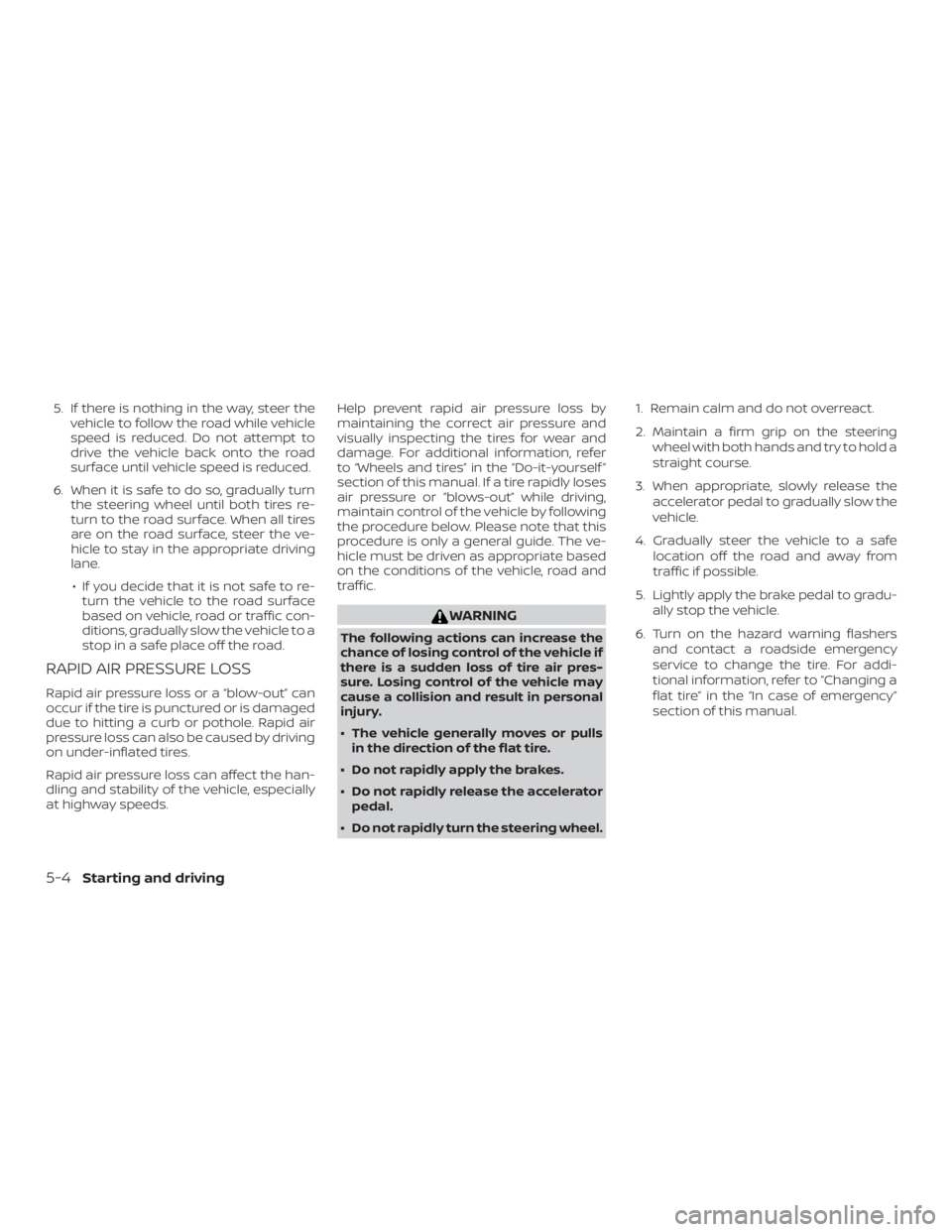
5. If there is nothing in the way, steer thevehicle to follow the road while vehicle
speed is reduced. Do not attempt to
drive the vehicle back onto the road
surface until vehicle speed is reduced.
6. When it is safe to do so, gradually turn the steering wheel until both tires re-
turn to the road surface. When all tires
are on the road surface, steer the ve-
hicle to stay in the appropriate driving
lane.
∙ If you decide that it is not safe to re- turn the vehicle to the road surface
based on vehicle, road or traffic con-
ditions, gradually slow the vehicle to a
stop in a safe place off the road.
RAPID AIR PRESSURE LOSS
Rapid air pressure loss or a “blow-out” can
occur if the tire is punctured or is damaged
due to hitting a curb or pothole. Rapid air
pressure loss can also be caused by driving
on under-inflated tires.
Rapid air pressure loss can affect the han-
dling and stability of the vehicle, especially
at highway speeds. Help prevent rapid air pressure loss by
maintaining the correct air pressure and
visually inspecting the tires for wear and
damage. For additional information, refer
to “Wheels and tires” in the “Do-it-yourself ”
section of this manual. If a tire rapidly loses
air pressure or “blows-out” while driving,
maintain control of the vehicle by following
the procedure below. Please note that this
procedure is only a general guide. The ve-
hicle must be driven as appropriate based
on the conditions of the vehicle, road and
traffic.
Page 223 of 346
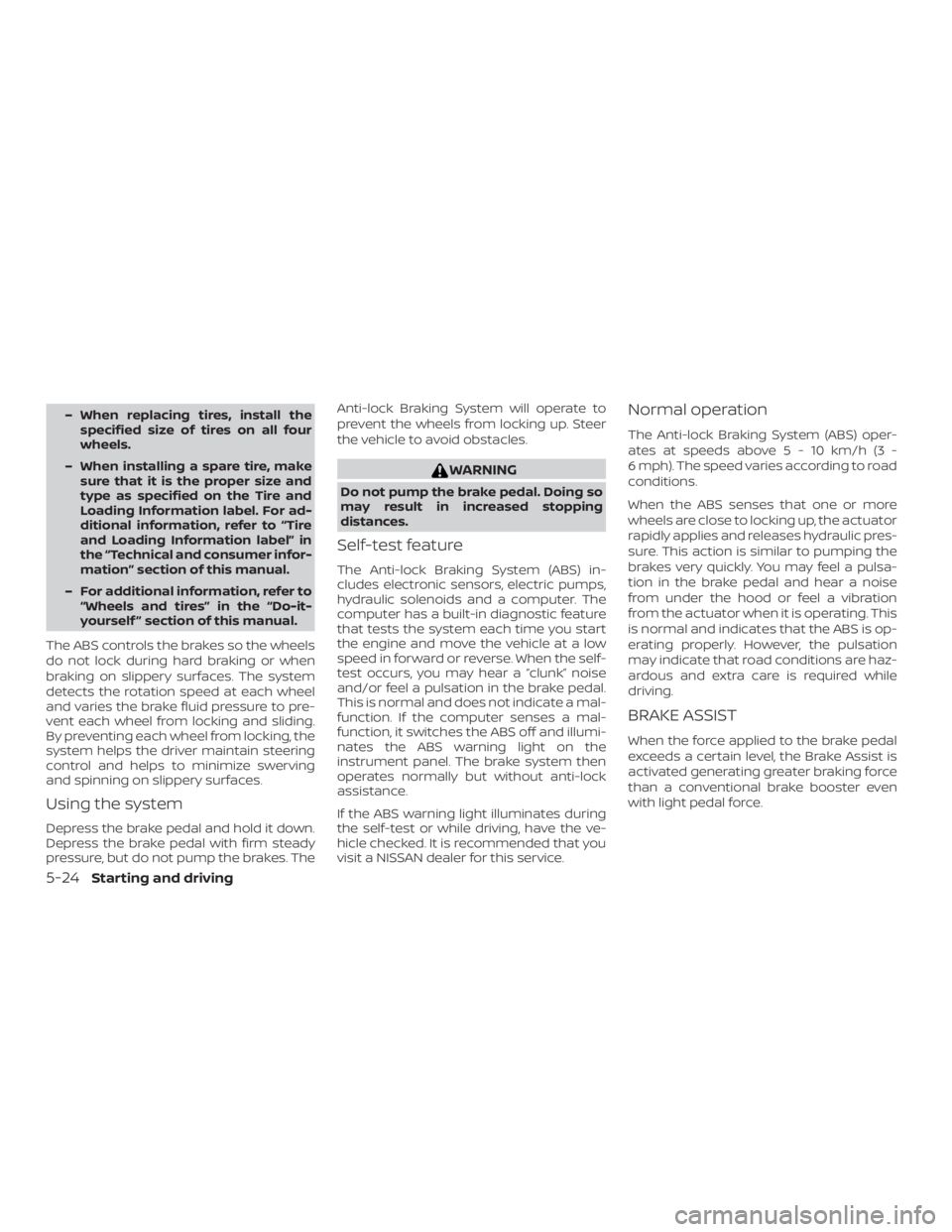
– When replacing tires, install thespecified size of tires on all four
wheels.
– When installing a spare tire, make sure that it is the proper size and
type as specified on the Tire and
Loading Information label. For ad-
ditional information, refer to “Tire
and Loading Information label” in
the “Technical and consumer infor-
mation” section of this manual.
– For additional information, refer to “Wheels and tires” in the “Do-it-
yourself ” section of this manual.
The ABS controls the brakes so the wheels
do not lock during hard braking or when
braking on slippery surfaces. The system
detects the rotation speed at each wheel
and varies the brake fluid pressure to pre-
vent each wheel from locking and sliding.
By preventing each wheel from locking, the
system helps the driver maintain steering
control and helps to minimize swerving
and spinning on slippery surfaces.
Using the system
Depress the brake pedal and hold it down.
Depress the brake pedal with firm steady
pressure, but do not pump the brakes. The Anti-lock Braking System will operate to
prevent the wheels from locking up. Steer
the vehicle to avoid obstacles.
Page 287 of 346
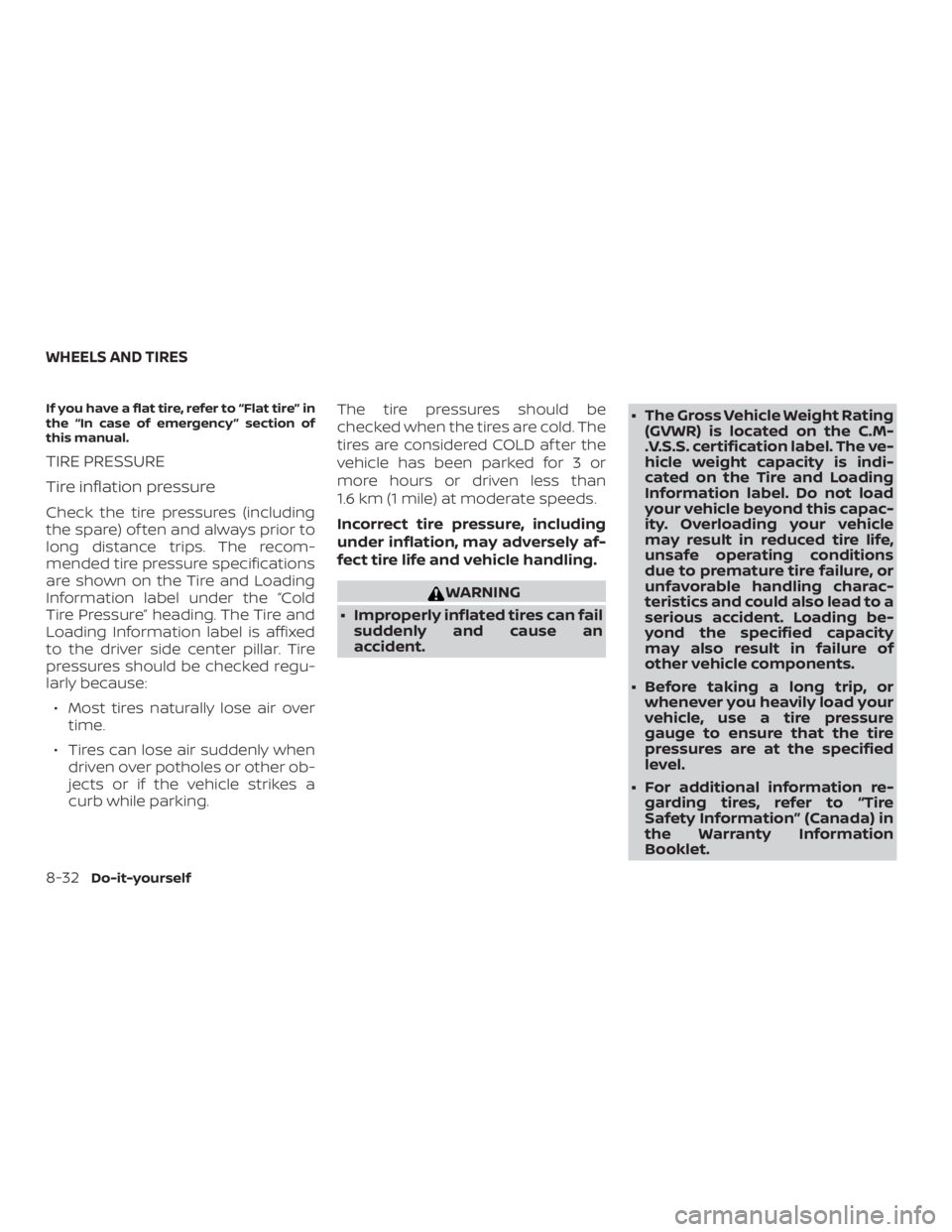
If you have a flat tire, refer to “Flat tire” in
the “In case of emergency ” section of
this manual.
TIRE PRESSURE
Tire inflation pressure
Check the tire pressures (including
the spare) of ten and always prior to
long distance trips. The recom-
mended tire pressure specifications
are shown on the Tire and Loading
Information label under the “Cold
Tire Pressure” heading. The Tire and
Loading Information label is affixed
to the driver side center pillar. Tire
pressures should be checked regu-
larly because:∙ Most tires naturally lose air over time.
∙ Tires can lose air suddenly when driven over potholes or other ob-
jects or if the vehicle strikes a
curb while parking. The tire pressures should be
checked when the tires are cold. The
tires are considered COLD af ter the
vehicle has been parked for 3 or
more hours or driven less than
1.6 km (1 mile) at moderate speeds.
Incorrect tire pressure, including
under inflation, may adversely af-
fect tire life and vehicle handling.
Page 296 of 346
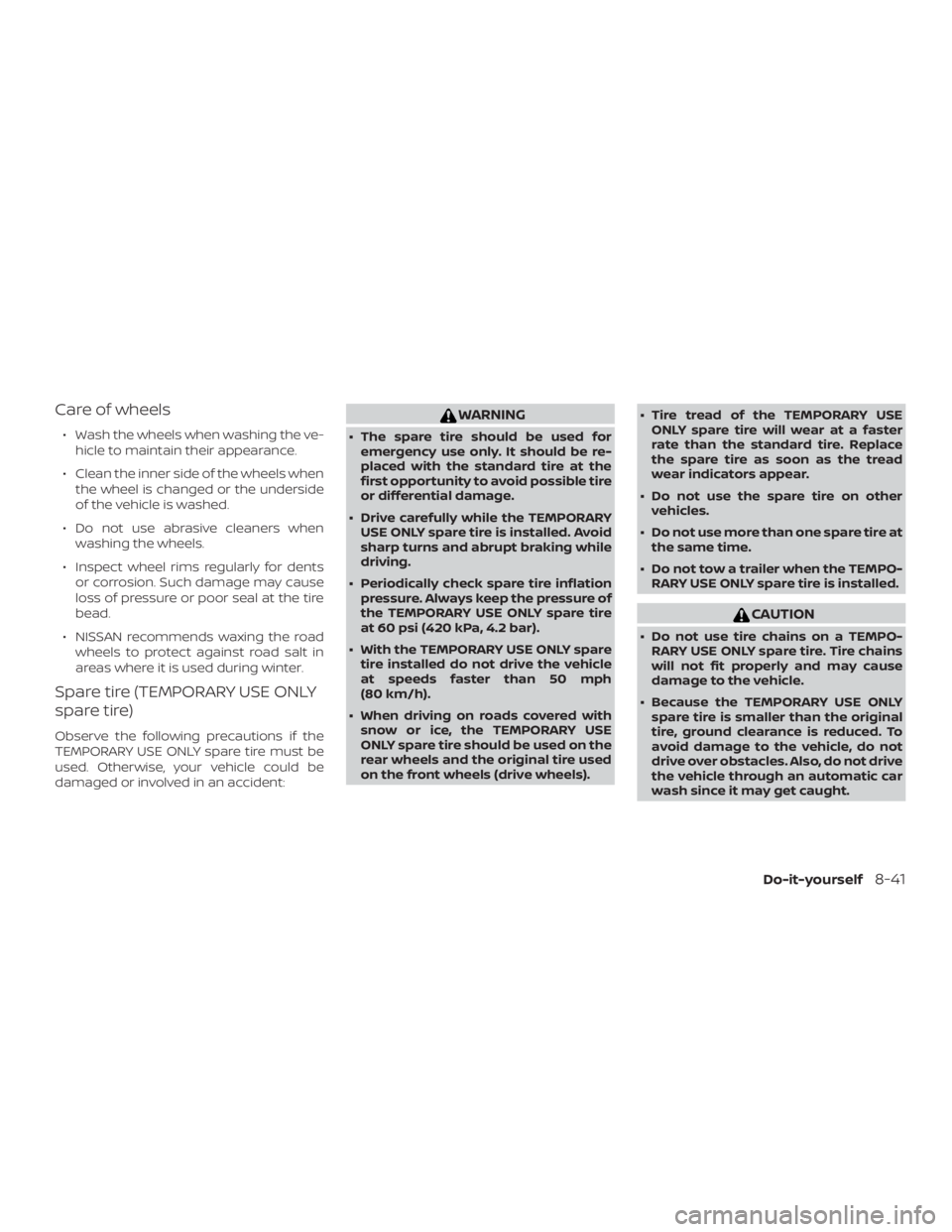
Care of wheels
∙ Wash the wheels when washing the ve-hicle to maintain their appearance.
∙ Clean the inner side of the wheels when the wheel is changed or the underside
of the vehicle is washed.
∙ Do not use abrasive cleaners when washing the wheels.
∙ Inspect wheel rims regularly for dents or corrosion. Such damage may cause
loss of pressure or poor seal at the tire
bead.
∙ NISSAN recommends waxing the road wheels to protect against road salt in
areas where it is used during winter.
Spare tire (TEMPORARY USE ONLY
spare tire)
Observe the following precautions if the
TEMPORARY USE ONLY spare tire must be
used. Otherwise, your vehicle could be
damaged or involved in an accident:
Page 330 of 346
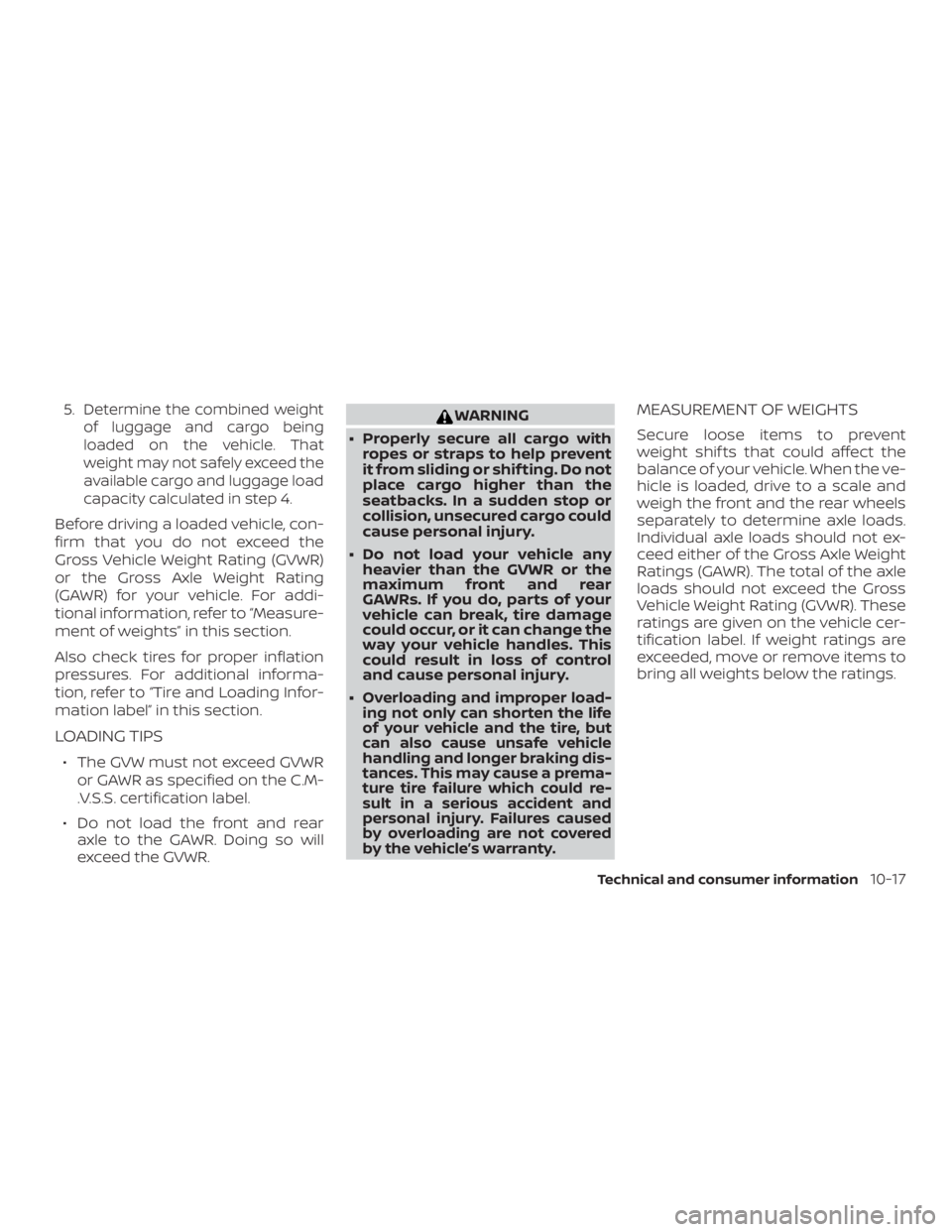
5.Determine the combined weight
of luggage and cargo being
loaded on the vehicle. That
weight may not safely exceed the
available cargo and luggage load
capacity calculated in step 4.
Before driving a loaded vehicle, con-
firm that you do not exceed the
Gross Vehicle Weight Rating (GVWR)
or the Gross Axle Weight Rating
(GAWR) for your vehicle. For addi-
tional information, refer to “Measure-
ment of weights” in this section.
Also check tires for proper inflation
pressures. For additional informa-
tion, refer to “Tire and Loading Infor-
mation label” in this section.
LOADING TIPS
∙ The GVW must not exceed GVWR or GAWR as specified on the C.M-
.V.S.S. certification label.
∙ Do not load the front and rear axle to the GAWR. Doing so will
exceed the GVWR.
Page 337 of 346
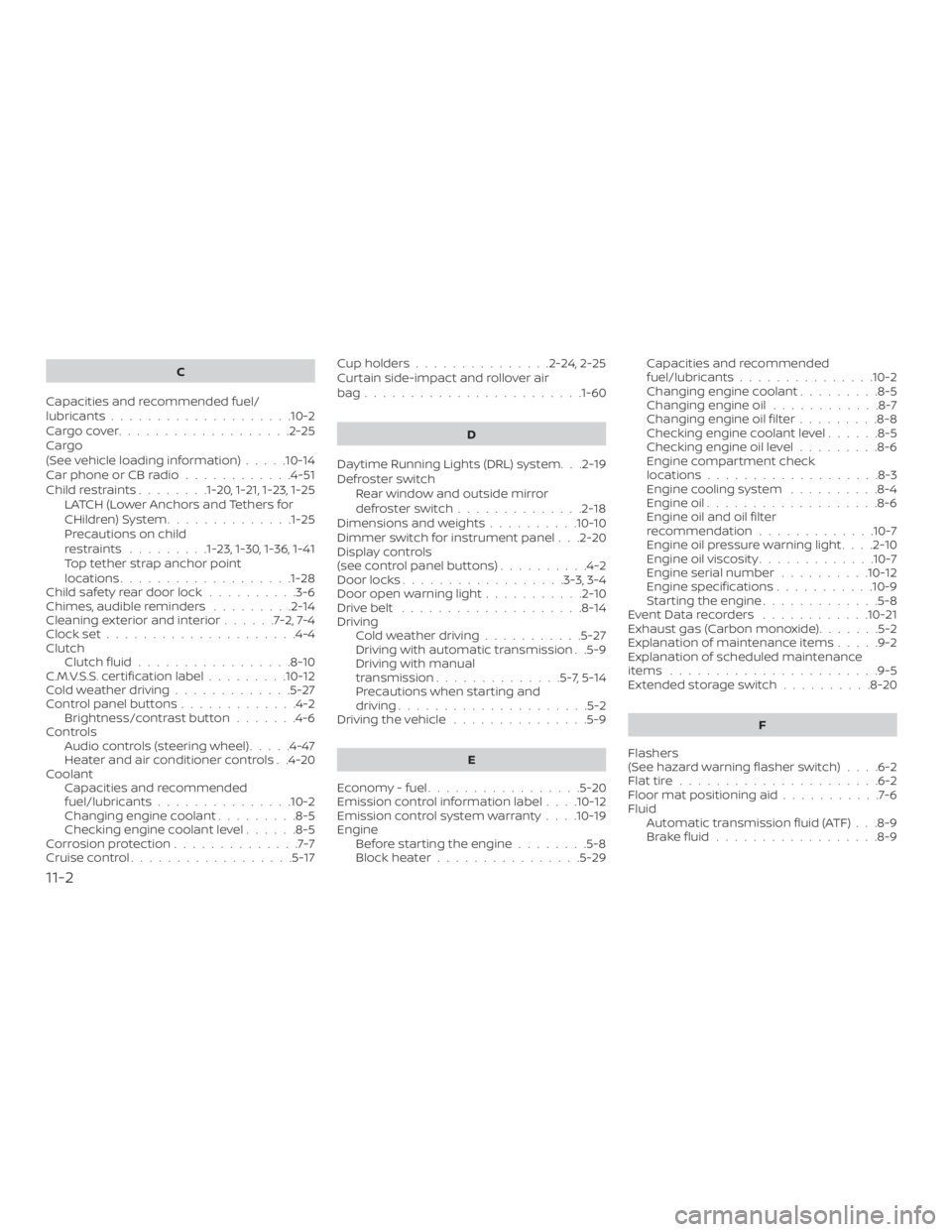
C
Capacities and recommended fuel/
lubricants....................10-2
Cargocover...................2-25
Cargo
(See vehicle loading information) .....10-14
Car phone or CB radio ............4-51
Childrestraints........1-20, 1-21, 1-23, 1-25 LATCH (Lower Anchors and Tethers for
CHildren)System..............1-25
Precautions on child
restraints .........1-23, 1-30, 1-36, 1-41
Top tether strap anchor point
locations.................. .1-28
Child safety rear door lock ..........3-6
Chimes, audible reminders .........2-14
Cleaningexteriorandinterior......7-2,7-4
Clockset.....................4-4
Clutch Clutchfluid.................8-10
C.M.V.S.S. certification label .........10-12
Coldweatherdriving.............5-27
Control panel buttons .............4-2
Brightness/contrast button .......4-6
Controls Audio controls (steering wheel) .....4-47
Heater and air conditioner controls . .4-20
Coolant Capacities and recommended
fuel/lubricants...............10-2
Changing engine coolant .........8-5
Checking engine coolant level ......8-5
Corrosionprotection..............7-7
Cruisecontrol..................5-17 Cupholders...............2-24,2-25
Curtain side-impact and rollover air
bag.......................
.1-60
D
Daytime Running Lights (DRL) system. . .2-19
Defroster switch Rear window and outside mirror
defrosterswitch..............2-18
Dimensions and weights ..........10-10
Dimmer switch for instrument panel . . .2-20
Display controls
(see control panel buttons) ..........4-2
Door locks ..................3-3,3-4
Door open warning light ...........2-10
Drivebelt ....................8-14
Driving Cold weather driving ...........5-27
Driving with automatic transmission . .5-9
Driving with manual
transmission ..............5-7,5-14
Precautions when starting and
driving.....................5-2
Drivingthevehicle ...............5-9
E
Economy - fuel .................5-20
Emission control information label . . . .10-12
Emission control system warranty . . . .10-19
Engine Before starting the engine ........5-8
Blockheater................5-29 Capacities and recommended
fuel/lubricants...............10-2
Changing engine coolant
.........8-5
Changing engine oil ............8-7
Changing engine oil filter .........8-8
Checking engine coolant level ......8-5
Checking engine oil level .........8-6
Engine compartment check
locations...................8-3
Engine cooling system ..........8-4
Engine oil ...................8-6
Engine oil and oil filter
recommendation .............10-7
Engine oil pressure warning light . . . .2-10
Engine oil viscosity .............10-7
Engine serial number ..........10-12
Engine specifications ...........10-9
Starting the engine .............5-8
EventDatarecorders ............10-21
Exhaust gas (Carbon monoxide) .......5-2
Explanation of maintenance items .....9-2
Explanation
of scheduled maintenance
items .......................9-5
Extended storage switch ..........8-20
F
Flashers
(Seehazardwarningflasherswitch)....6-2
Flattire......................6-2
Floormatpositioningaid...........7-6
Fluid Automatic transmission fluid (ATF) . . .8-9
Brakefluid..................8-9
11-2
Page 341 of 346
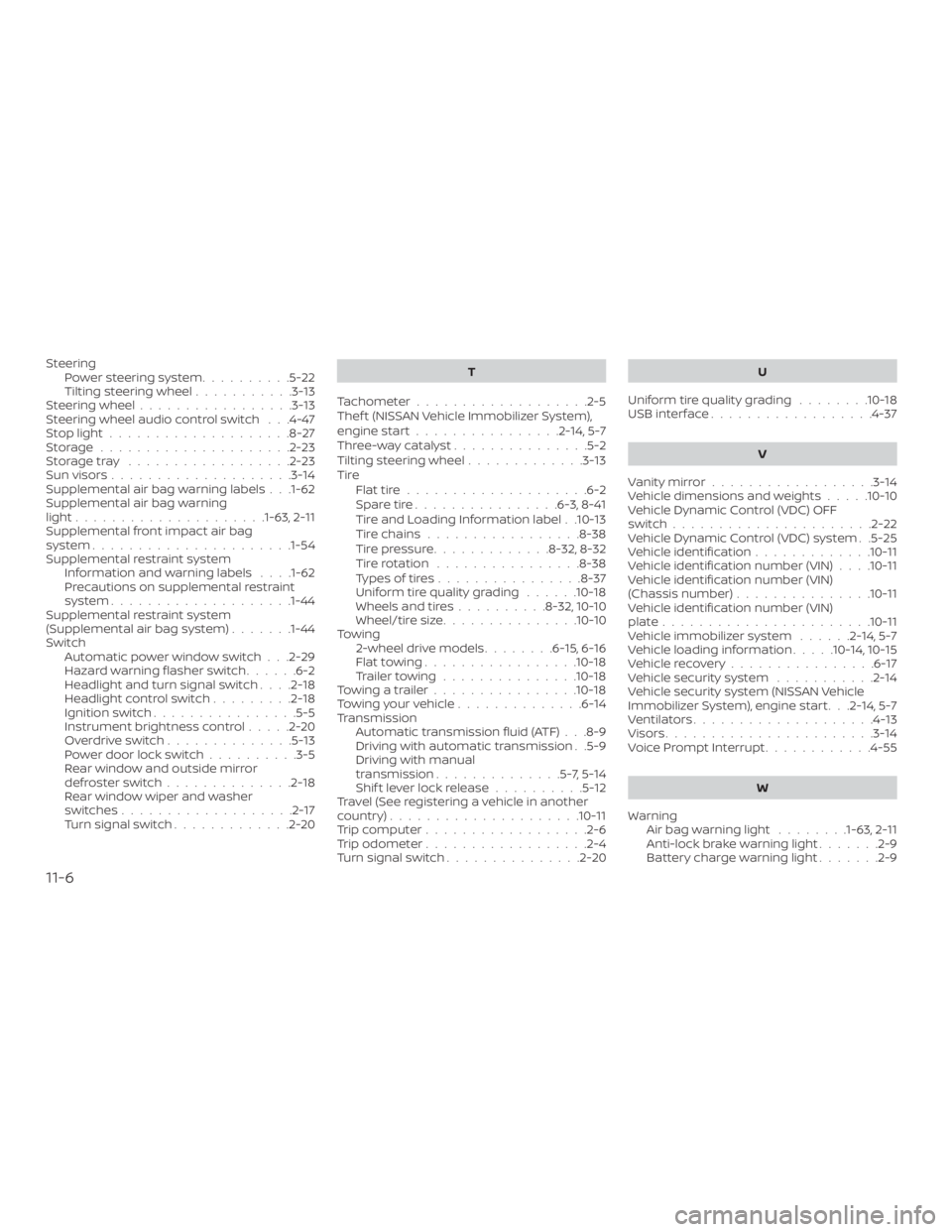
SteeringPower steering system ..........5-22
Tilting steering wheel ...........3-13
Steering wheel .................3-13
Steering wheel audio control switch . . .4-47
Stoplight....................8-27
Storage.....................2-23
Storagetray ..................2-23
Sunvisors....................3-14
Supplemental air bag warning labels . . .1-62
Supplemental air bag warning
light.................... .1-63, 2-11
Supplemental front impact air bag
system ..................... .1-54
Supplemental restraint system Information and warning labels . . . .1-62
Precautions on supplemental restraint
system ....................1-44
Supplemental restraint system
(Supplemental air bag system) .......1-44
Switch Automatic power window switch . . .2-29
Hazard warning flasher switch ......6-2
Headlight and turn signal switch ....2-18
Headlightcontrolswitch.........2-18
Ignition switch ................5-5
Instrument brightness control .....2-20
Overdriveswitch..............5-13
Power door lock switch ..........3-5
Rear window and outside mirror
defrosterswitch..............2-18
Rear window wiper and washer
switches ...................2-17
Turn signal switch .............2-20 T
Tachometer ...................2-5
Thef t (NISSAN Vehicle Immobilizer System),
engine start ................2-14,5-7
Three-waycatalyst...............5-2
Tilting steering wheel .............3-13
Tire Flattire....................6-2
Spare tire ................6-3,8-41
Tire and Loading Information label . .10-13
Tire chains .................8-38
Tire pressure .............8-32,8-32
Tirerotation ................8-38
Types of tires ................8-37
Uniform tire quality grading ......10-18
Wheels and tires ..........8-32,10-10
Wheel/tire size ...............10-10
Towing 2-wheel drive models ........6-15,6-16
Flattowing.................10-18
Trailertowing...............10-18
Towingatrailer................10-18
Towingyourvehicle..............6-14
Transmission Automatic transmission fluid (ATF) . . .8-9
Driving with automatic transmission . .5-9
Driving with manual
transmission ..............5-7,5-14
Shiftleverlockrelease..........5-12
Travel (See registering a vehicle in another
country) .....................10-11
Trip computer ..................2-6
Trip odometer ..................2-4
Turn signal switch ...............2-20 U
Uniform tire quality grading ........10-18
USBinterface..................4-37
V
Vanitymirror..................3-14
Vehicle dimensions and weights .....10-10
Vehicle Dynamic Control (VDC) OFF
switch......................2-22
Vehicle Dynamic Control (VDC) system . .5-25
Vehicle identification .............10-11
Vehicle identification number (VIN) . . . .10-11
Vehicle identification number (VIN)
(Chassis number) ...............10-11
Vehicle identification number (VIN)
plate.......................10-11
Vehicle immobilizer system ......2-14,5-7
Vehicle loading information .....10-14,10-15
Vehiclerecovery................6-17
Vehicle security system ...........2-14
Vehicle security system (NISSAN Vehicle
Immobilizer System), engine start . . .2-14, 5-7
Ventilators ....................4-13
Visors.......................3-14
Voice Prompt Interrupt ............4-55
W
W
arning Airbagwarninglight ........1-63, 2-11
Anti-lock brake warning light .......2-9
Battery charge warning light .......2-9
11-6